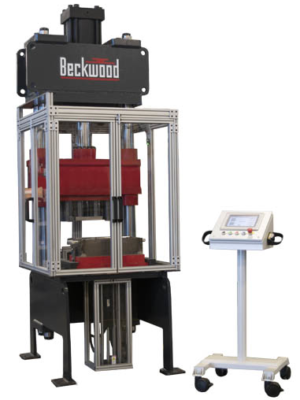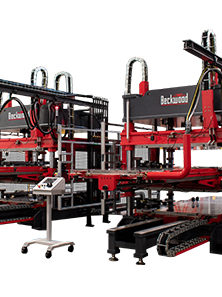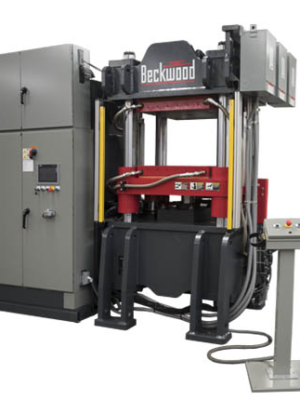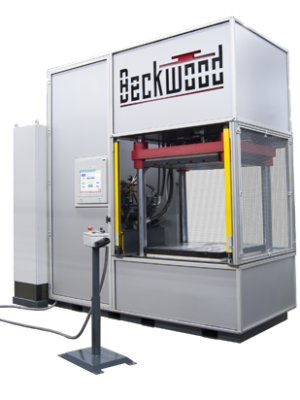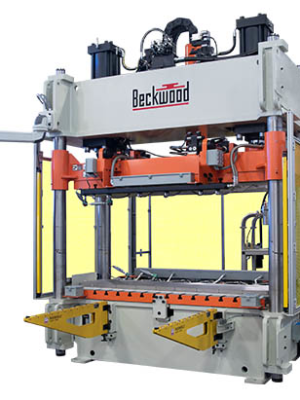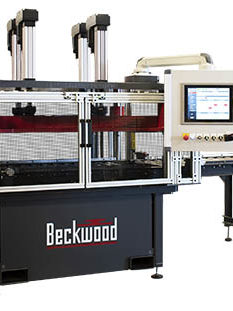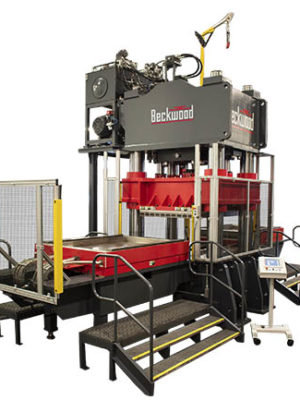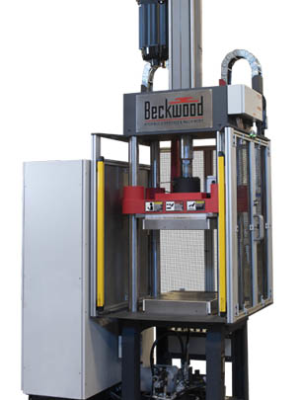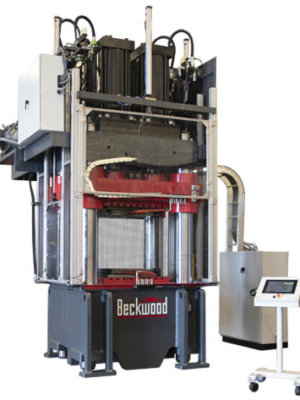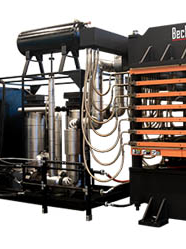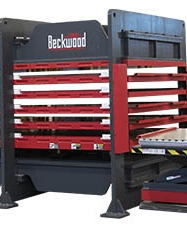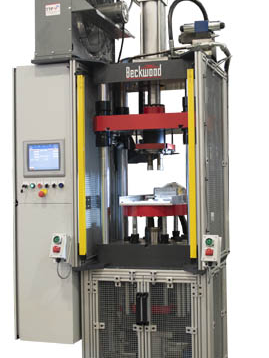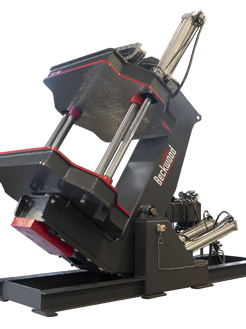As the popularity of thermoformed, reaction injection-molded (RIM), extruded, and powder-compacted parts continues to increase, so does the demand for compression molding presses with heating and cooling capabilities. Once reserved for specialized aerospace applications, compression molding presses are now used in a variety of industries to form parts from essentially any material, including metals, alloys, fiber-reinforced plastics, powders, resins, SMC, BMC, composites, and rubber.
Beckwood’s compression molding presses are engineered specifically to maximize process efficiency. From maintaining consistent heat throughout a specified dwell period to precision pressure ramping, managing burp cycles, and collecting specific cycle data for part quality verification, Beckwood heated presses help you perfect your forming operation.
Compression Molding Press Features:
- Electric, oil, or steam heating systems
- Water-cooled platens
- Multi-zone temperature control for extreme uniformity
- Multiple cavities for increased productivity
- Booking rams to facilitate ergonomic tool cleaning/inspection
- Bed shuttles for simplified tool loading and unloading
- Automatic insulated door systems for maximum heat efficiency
- Pneumatic dwell systems for energy efficiency
- Variable Frequency Drive for efficiency and noise reduction
- Data acquisition systems
- Active Leveling Control to counteract the effects of off-center loading
Types of Compression Molding Presses
We engineer and manufacture presses for a wide breath of compression molding applications, including the following:
- Hot Forming & Cold Forming
- Injection Molding
- Reaction Injection Molding (RIM)
- Composite Forming
- Powder Compacting
- Extrusion Forming
- HDPE Sheet Making
- UHMW Sheet Making
Consult a Beckwood engineer about your compression press molding needs
WHITEPAPER: Composite Forming in a Compression Molding Press
Introduction to Composites
Composites are quickly becoming the industry standard over materials like steel, titanium, concrete, and wood due to their inherent benefits which include: light weight, high strength, low maintenance, formability, corrosion, impact and electrical resistance, and easy installation.
A composite is defined as two or more materials with different physical or chemical properties that are combined to leverage the benefits of both materials without destroying their original makeup. Composites are made by joining a “reinforcement” and a “matrix” to create a new polymer with characteristics that are superior to either material alone. The types of reinforcements and matrices used, and their corresponding ratios, are what determines a composite’s overall strength, weight, rigidity, and other physical properties.
Many materials can be classified as composites, but in today’s world of lightweighting and efficiency, the most common composites are made from resins with fiber reinforcement, also known as fiber-reinforced polymers or FRPs.
As the need for lightweight, high-strength products continues to increase within nearly every industry, it is crucial to understand several key factors and process limitations when researching new hydraulic or servo-electric presses to form composites. This article explores three primary questions to ensure you get the best machinery for the job.
What is the best way to form composites into a finished part?
While several methods exist to form composite materials—pultrusion, autoclave curing/molding, resin transfer molding, filament winding, etc.—compression molding is the most common. Compression molding is typically performed using a hydraulic or servo-electric press with heated and/or cooled platens to achieve the desired forming temperatures. In some cases, the tooling may also be heated to facilitate consistent, even heat distribution closer to the part that is being formed. Compression molding presses can be configured vertically or horizontally depending on the needs of the application they’re performing and can be post/bushing-guided or gib-guided to achieve precision goals.
Thermosets like Sheet Molding Compound (SMC) and Bulk Molding Compound (BMC) are the most common composite materials used in the compression molding process. Both are made by combining various ratios of resins, fillers, and fiber reinforcements, but their physical properties and usage are somewhat different.
Sheet Molding Compound (SMC) is a high-strength composite material with a glass reinforcement. It is made by combining the ingredients above in an open box or mold and letting them rest until hardened. The large sheets are commonly used in the automotive and aerospace industries for large exterior body segments such as wings, quarter panels, hoods, tailgates, and other parts of the structure. Bulk Molding Compound (BMC), also known as dough molding compound (DMC), is made by mixing the resin, filler, reinforcement, and catalyst into a viscous paste. The paste is then fed into an extruder to produce a rope and aged until the rope has the consistency of putty or dough. Prior to forming, the rope is cut into smaller pieces, or charges, and formed using one of the primary compression molding methods outlined below. Because BMC’s have a lower fiber-to-weight ratio than SMC’s, their mechanical properties like tensile strength are lower than those of SMC composites.
There are two primary compression molding processes used to form composite parts: thermoforming and injection molding. Choosing the right one depends on the properties of the material being formed. For example, does it need to be heated, injected, compacted, or any combination thereof?
Thermoforming
Thermoforming is a compression molding process that uses heat and pressure to form substrates like plastics, resins, epoxies, and other materials into finished parts. Presses designed for thermoforming use heated platens and/or heated tooling to create the ideal molding environment for the materials being formed. During a thermoforming cycle, pressure is applied during the heating, dwelling, and cooling stages to make the final shape and ensure proper curing and density thresholds are achieved.
The tonnage requirements for a press to thermoform a particular composite material are determined by the composite’s tensile strength (or fiber-to-resin ratio). For example, materials with a higher glass content like SMC’s require a higher forming pressure. Thus, thin materials and simple shapes require less time and force to produce in a compression molding press compared to complex geometries made from thicker materials.
Flexible programming is key to successful compression molding. The ability to tell the press when to apply pressure, how long to dwell, or how much heat to provide at any point throughout the forming cycle will determine the efficacy of the finished part. And saving these optimal part “recipes” for fast recall makes the process easy and repeatable.
While this process is great for many composites, it can be challenging to perform with flammable or combustible materials due to the increased temperatures on the heated platens. Additionally, heat control can be difficult if you’re using an improper heating method for your application. Learn more about this topic in our whitepaper Temperature Check: Choosing the Right Heating Method for your Application.
Injection Molding & Reaction Injection Molding
During the injection molding process, resin powders or pellets are dispensed into the press via a hopper. They are then heated to their liquification point and injected into the die via a pressurized screw or plunger. In the mold, the liquid resin is distributed into the various cavities via a main channel or sprue. Once the material cools and solidifies, the mold is opened, and the finished products and sprue are ejected.
Injection molding presses are often engineered in a horizontal configuration to allow for optimal material flow into the die cavities. To increase precision, operator safety, and throughput, many manufacturers opt to automate to their injection molding machines. This could include automated pellet weighing and dispensing systems, programmable pre-heat, dwell and cooling cycles, or even robots to extract the finished parts.
Reaction Injection Molding (RIM) is most commonly used to manufacture polyurethane parts. It differs from traditional injection molding because it requires the combination of two liquid polymers rather than thermoplastic pellets. Once pumped or injected into the heated mold, the liquids generate an exothermic reaction to create the desired polyurethane. Depending on the liquids used, the finished part could be rigid or flexible.
Presses used for reaction injection molding are essentially large clamps that hold the tooling closed while the substrate inside cools and hardens. RIM presses are often low tonnage (under 100 tons) and can have rotating and/or tilting bases to facilitate even coating of the liquids inside the die cavity. Tooling for RIM presses is cheaper and quicker to source than traditional injection molding tooling because it doesn’t have to be engineered to withstand high pressures or high temperatures.
How do I ensure precision standards are met when forming composites?
Several technologies exist to increase precision during a compression molding cycle. From electro-mechanical actuators to automated weighing and dispensing systems and beyond, choosing the right options will ensure your manufacturing success now and could even future-proof your forming operation as composite materials evolve. Here are a few ways to maximize precision and process repeatability when forming composites:
Actuator Type
Servo-electric actuators offer positional repeatability within +/-0.0005-in., the highest precision rate of any actuator available today. Because they achieve full forming pressure at any point throughout the stroke, you can control multiple cycle parameters including travel distance, speed, pressure, and return position. Additionally, servo-electric actuators offer instant feedback for diagnostics and maintenance as well as data acquisition to measure and record torque, force, position, and time at a rate of 1 sample per millisecond.
Hydraulic presses are typically less accurate compared to servo-electric, but they do offer full tonnage throughout the stroke, so you can still control the multitude of cycle parameters mentioned above. They are also an excellent option for applications requiring tonnages beyond the capacity of electro-mechanical (above 200 tons) and can be outfitted with proportional/servo valves and high-speed motion controllers to increase precision.
Programming
As noted previously, flexible programming with recipe storage and recall is the key to successful compression molding for composites. Program features like pressure and temperature ramping, infinite dwell capability, designated burp cycles, and in-press quality checks are all vital and provide easy traceability on part quality as well as the press’ accuracy and overall performance.
Active Leveling Control
Active Leveling Control (ALC) is a unique option available only on Beckwood hydraulic presses that uses closed-loop control to maintain precise bed-to-ram parallelism despite off-center loading or tooling warpage resulting from prolonged exposure to high temperatures. Presses equipped with ALC rely on a high-speed motion controller, linear transducers, and proportional control valves to synchronize press actuators. The multi-axis high-speed motion controller provides less than 1-millisecond control loop time.
Active Leveling Control is offered in either 2- or 4-axis depending on the application. Two-axis control provides either left-to-right or front-to-rear parallelism. For users requiring both left-to-right and front-to-rear parallelism, four-axis control is recommended.
Automation
Integrating automated components such as robots, weighing and dispensing systems, shuttles, laser scanners, and more will remove the potential for human error from your forming cycle. In addition to the increase in precision and throughput, these connected devices can all be controlled and monitored by a single operator from a single PLC connected to the press.
What are the limitations of composites?
Composites have some limitations due to the complex manufacturing needs of the various fibers and matrices. Because of this, composites can be more difficult and more costly to fabricate than traditional materials like aluminum or steel. When determining whether a new part should be made from composites or traditional materials, you should evaluate your annual production goals and budget. In some cases, metal forming on a traditional press may be the better option.
Cost
The biggest factor preventing widespread adoption of composites is material cost. Research and development of new compounds is ongoing, and finding the right combination of fibers and matrices to achieve your desired strength and weight tolerances requires in-depth knowledge of how composites are made. Fibers are created by bonding thousands of atoms into crystals which are then weaved into threads. Matrices (resins) are relatively low in cost, but if you require temperature and/or environmental resistance, prices can increase exponentially. The time it takes to create fibers and matrices and combine them to make a viable composite material is often a deterring factor when choosing between manufacturing composites or forming metals.
With energy costs skyrocketing across the United States, many manufacturers cannot afford to run production equipment continually and only generate one or two parts per shift per machine. While options like soft-starters and pneumatic dwell systems exist to reduce energy consumption on hydraulic presses, it is often not enough of a cost savings to justify adding a composite forming operation.
Production Time
Machinery cycle times on composite forming presses are significantly longer than traditional metal forming. This is primarily due to the heating, cooling, and pressure holding (dwell) that are required for the composite part to cure and form properly on a compression molding press. It is not uncommon to see cycle times beyond two hours for certain composites. While advances are being made to improve part cycle times, compression molding composite materials almost always requires more time than traditional metal forming applications.
Maintenance & Repairs
Although composites are known for being durable and long-lasting, the repair process is complex and costly compared to traditional materials. It can be difficult to identify and troubleshoot weak or damaged areas, and determining what type of repair is needed depends on the part’s thickness, core, shape, size, and curvature. In some cases, a repair may not even be possible.
Conclusions on Composite Forming
As a global OEM, we see composites used in nearly every industry including aerospace & defense, energy & utilities, medical, automotive, construction, and consumer goods to form components we use every day. From airplane cabin interiors and power poles to roofing shingles and military helmets, composites are everywhere.
Understanding the various forming processes and equipment required to make composite parts can be challenging, so partnering with an OEM who is knowledgeable about the intricacies of the compression molding process is critical.
Ready to start your composite forming project? Get a quote for a custom compression molding press.
FAQ: What Can a Compression Molding Press be Used For?
A compression molding press can be used to compress, cure, and form plastic, rubber, SMC, BMC, and composites for a variety of industries to make the products we use every day. Below are just a few examples.
If you don’t see your industry, don’t worry; we can manufacture a press to benefit your process.
AEROSPACE |
|
AGRICULTURE |
|
AUTOMOTIVE |
|
CONSTRUCTION & INFRASTRUCTURE |
|
CONSUMER PRODUCTS |
|
DEFENSE & MILITARY |
|
ELECTRONICS |
|
MEDICAL |
|





